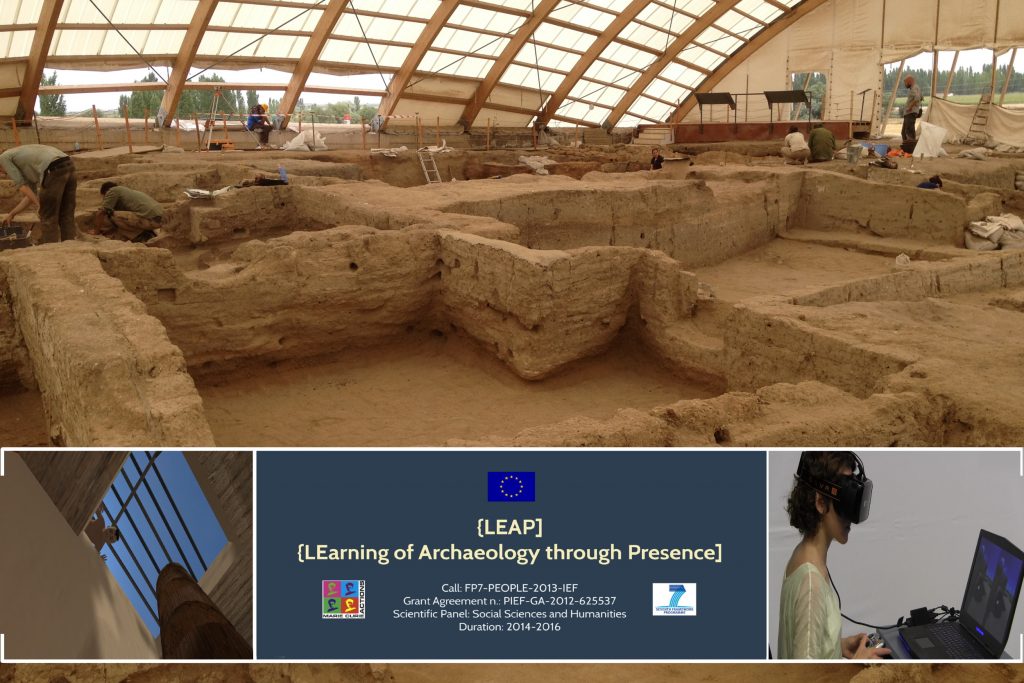
![]() Il progetto ÇH3D si basa su una ricostruzione 3D del sito Neolitico di Çatalhöyük in Turchia e del contesto geografico in cui è inserito. Dell’edificio 39, situato nel settore nord, si è ricostruito in ogni suo parte anche l’interno; sono stati modellati gli oggetti della vita quotidiana, come ceste, oggetti di ceramica, utensili in pietra, piccole statuine, stuoie, borse in pelle, ecc. La vita di ogni giorno è rappresentata attraverso una serie di scene compresi anche persone ed animali, impegnati in diverse attività. Si può accedere ad informazioni testuali, contenute all’interno di finestre che compaiono nel paesaggio. Obiettivo è quello di fornire linee guida per la progettazione e la valutazione di ambienti virtuali, il cui scopo è quello di migliorare la comprensione e la fruizione del Patrimonio Culturale. Nel dettaglio, si vorrebbe testare se si ottiene una migliore comprensione del sito oggetto di studio, attraverso una ricostruzione che non sia semplicemente architettonica, ma che faccia vivere anche il paesaggio popolandolo con oggetti e personaggi, che si muovono ed agiscono all’interno della ricostruzione.
Il progetto ÇH3D si basa su una ricostruzione 3D del sito Neolitico di Çatalhöyük in Turchia e del contesto geografico in cui è inserito. Dell’edificio 39, situato nel settore nord, si è ricostruito in ogni suo parte anche l’interno; sono stati modellati gli oggetti della vita quotidiana, come ceste, oggetti di ceramica, utensili in pietra, piccole statuine, stuoie, borse in pelle, ecc. La vita di ogni giorno è rappresentata attraverso una serie di scene compresi anche persone ed animali, impegnati in diverse attività. Si può accedere ad informazioni testuali, contenute all’interno di finestre che compaiono nel paesaggio. Obiettivo è quello di fornire linee guida per la progettazione e la valutazione di ambienti virtuali, il cui scopo è quello di migliorare la comprensione e la fruizione del Patrimonio Culturale. Nel dettaglio, si vorrebbe testare se si ottiene una migliore comprensione del sito oggetto di studio, attraverso una ricostruzione che non sia semplicemente architettonica, ma che faccia vivere anche il paesaggio popolandolo con oggetti e personaggi, che si muovono ed agiscono all’interno della ricostruzione.
![]() The ÇH3D experience is based on a 3D model of the Neolithic settlement of Çatalhöyük in Turkey and the natural environment surrounding it. The interior of Building 49 in the North Shelter has been also fully reconstructed. Material culture is represented through an array of 3D-modelled objects, (e.g. baskets, pottery, stone tools, figurines, mats, leather bags, etc). Daily life is represented through a series of scenes including animals and human characters performing different tasks. One condition also contains floating message boxes displaying textual information. The goal is to provide empirically tested design and evaluation guidelines for virtual environments that aim at enhancing understanding, relevance and enjoyment of Cultural Heritage. More specifically, it wanted to test if an enhanced feeling of Cultural Presence, that is, of “being then and there” (generated in different versions by introducing successively objects, text, characters, scenes and narrations), obtained better results in comparison with an architectural reconstruction of the site.
The ÇH3D experience is based on a 3D model of the Neolithic settlement of Çatalhöyük in Turkey and the natural environment surrounding it. The interior of Building 49 in the North Shelter has been also fully reconstructed. Material culture is represented through an array of 3D-modelled objects, (e.g. baskets, pottery, stone tools, figurines, mats, leather bags, etc). Daily life is represented through a series of scenes including animals and human characters performing different tasks. One condition also contains floating message boxes displaying textual information. The goal is to provide empirically tested design and evaluation guidelines for virtual environments that aim at enhancing understanding, relevance and enjoyment of Cultural Heritage. More specifically, it wanted to test if an enhanced feeling of Cultural Presence, that is, of “being then and there” (generated in different versions by introducing successively objects, text, characters, scenes and narrations), obtained better results in comparison with an architectural reconstruction of the site.
Istituzioni Coinvolte: Foundation of the Hellenic World; Universitat Pompeu Fabra; The University of York; Çatalhöyük Research Project (University of Stanford); CEV: Escuela Superior de Comunicación, Imagen y Sonido; Progetto LEAP
